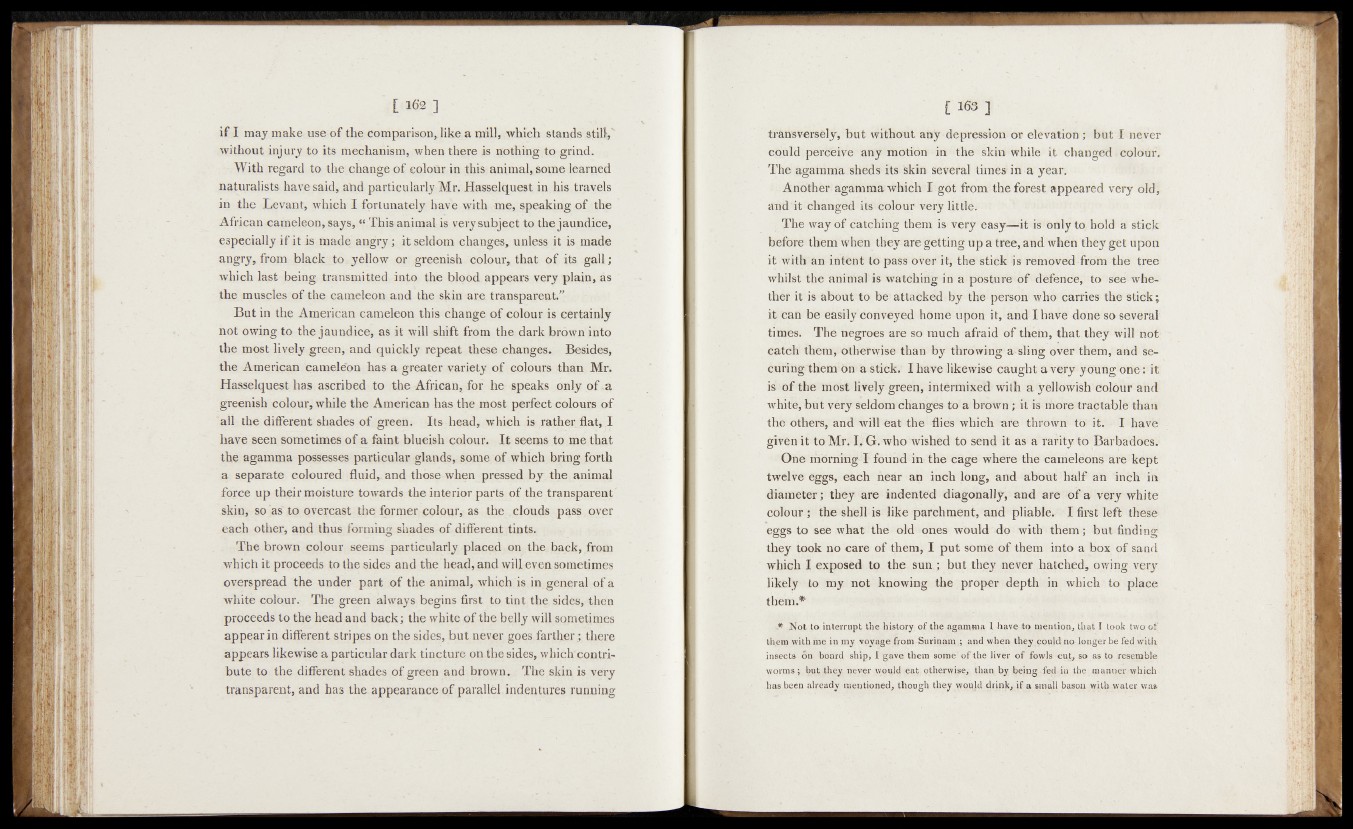
if I may make- use: of the. comparison, like, a mill, which stands still,'
without injury to its mechanism, when there is Nothing to grind. ;
With regard to the. change-of colour in this : animal, soine learned
naturalists have said, atid particularly Mr. Hasselquest in his travels
in the Içvant, whieh I fortunately have with me, speaking of the
African »eaj&r^eon, say Thisanimafis very subject to the jaundice,
especially if it is made angry ; it seldom changes, unless it is made
angry, from black to «yellow or greenish Colour,, that of its gall;
which last being transmitted into the blood appears very plain, as
the muscles of the caméléon and the skin are transparent.”
But in the American caméléon this change of colour is certainly
not owing to the jaundice* as it will shift from the dark brown into
the most lively green, and quickly repeat these changes. Besides,
the American caméléon has a greater variety of colours than Mr.
Hasselquest has ascribed to the African* for he speaks only of m
greenish colour, while the American has the most perfect colours of
‘all the different shades of green. Its head, whick is ratherjflat, I
have seen sometimes of a taint blueish colour. I t seems to me that
the agamma possesses particular glands,- some of which; bring forth
a separate coloured fluid».and those when pressed by the. animal
force up their moisture towards the interior parts of the transparent'
skin, so 'as' to overcast the fqrmer coloqr,- as the . clouds pass| oyer
each other, and thus forming shades of different.jtints.
The brown colour seems particularly placed on the.; back, from
which it proceeds to the sides and the head, and wdf even sometimes
overspread the under part of the animal, which is in, general of a
white colour. The green always begins first, to tint, the sides, then
proceeds to the head and back; the white of the belly will sometimes
appear in different stripes on the sides, but never goes.farther ; there
appears likewise a particular dark tincture on.the sides, which'contribute
to the different shades of green and brown. The skin is very
transparent, and has the-appearance of parallel, indentures running
transversely, but without any depression or elevation; but I never
cqtild pérdèive any motion in the skin while it changed»colour.
The agamma sheds-its skin several times* in a year.
• • Anothèr agamma; which?! got fromthe forest appeared very old,
aud it Ghanged itéi’OölbuP'vefy little. -
The way of catching them is7 very1 easy-^it is4only to hold a stick
before them when they -are getting up a tree, and when they get upon
it with an intêht to-pas^over it, tbu stick'-is removed from the tree
whilst the animal is watching in a posture of defence, to' see whether
it-is about’tóffee* attacked by the person who- carries the Stidk;
it can be easily conveyed home upon it, and f have done*SO several
times. The negroes are so müch afraid of them, that they will not; r
catcli themV;ótherWise than by throwing a- sli ng over them, and securing
them bn a stick.* I have-likewise caught a very young one : it
i$>of the most lively green, intermixed with a^yellowish colour and
white, but vêry seldom changës to a brown; it is more tractable than
the others, and will èat the flies which are thrown to it. - I have
given it to Mr. I, G. who wished to Send it as a rarity »t-o Barbadoes.
One möming' Ï fou nd in the cage where the cairieleonsare kept
twelve eggs, each hear an inch long, and about half an Inch in
diameter; they are indented diagonally, and are of a very white
colour; the shell is like parchment, and pliable.- I first left these
eggs to see what the old ones would’ do with them«; -but finding
they took no care of them, I put some of them into a box of sand
which I exposed tp the sun.; but they never hatched, owing very
likely to my not knowing the proper depth in which to place
them.*
Not to interrupt the historyof.the agamma I have-to mention, that I took two o f
th.ém with me in my voyage froni Surinarnand when-they.could no longer he fed with
insects oh board ship, 1 gave them some' o f the liver o f fowls- cut, so as to resemble
worms; bu^hhey;. never- would eat otherwise,- than by being/.fed-jin the manuer which
has been already mentioned, though they would drink, if a small bason with water was